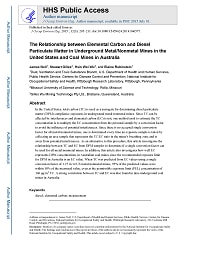Mining Publication: The Relationship between Elemental Carbon and Diesel Particulate Matter in Underground Metal/Nonmetal Mines in the United States and Coal Mines in Australia
Original creation date: March 2015
Authors: JD Noll, S Gilles, HW Wu, EN Rubinstein
In the United States, total carbon (TC) is used as a surrogate for determining diesel particulate matter (DPM) compliance exposures in underground metal/nonmetal mines. Since TC can be affected by interferences and elemental carbon (EC) is not, one method used to estimate the TC concentration is to multiply the EC concentration from the personal sample by a conversion factor to avoid the influence of potential interferences. Since there is no accepted single conversion factor for all metal/nonmetal mines, one is determined every time an exposure sample is taken by collecting an area sample that represents the TC/EC ratio in the miner's breathing zone and is away from potential interferences. As an alternative to this procedure, this article investigates the relationship between TC and EC from DPM samples to determine if a single conversion factor can be used for all metal/nonmetal mines. In addition, this article also investigates how well EC represents DPM concentrations in Australian coal mines since the recommended exposure limit for DPM in Australia is an EC value. When TC was predicted from EC values using a single conversion factor of 1.27 in 14 US metal/nonmetal mines, 95% of the predicted values were within 18% of the measured value, even at the permissible exposure limit (PEL) concentration of 160 μg/m3 TC. A strong correlation between TC and EC was also found in nine underground coal mines in Australia.
- A Computer Software Program that Estimates Air Quantity Requirements in Large Opening Stone Mines
- Effects of Sampling Artifacts on Occupational Samples of Diesel Particulate Matter
- Evaluation of the SKC� DPM Cassette for Monitoring Diesel Particulate Matter in Coal Mines
- Field Evaluation of Diesel Particulate Matter Using Portable Elemental Carbon Monitors
- Measuring Diesel Particulate Matter in Underground Mines Using Submicron Elemental Carbon as a Surrogate
- Near Real Time Monitoring of Diesel Particulate Matter in Underground Mines
- A Predictive Model for Elemental Carbon, Organic Carbon and Total Carbon Based on Laser Induced Breakdown Spectroscopy Measurements of Filter-collected Diesel Particulate Matter
- Relationship Between Elemental Carbon, Total Carbon, and Diesel Particulate Matter in Several Underground Metal/nonmetal Mines
- Technology News 514 - The Air Quantity Estimator (AQE): A New Computer Software Tool for Large-opening Mine Ventilation Planning
- Toward developing a new occupational exposure metric approach for characterization of diesel aerosols
